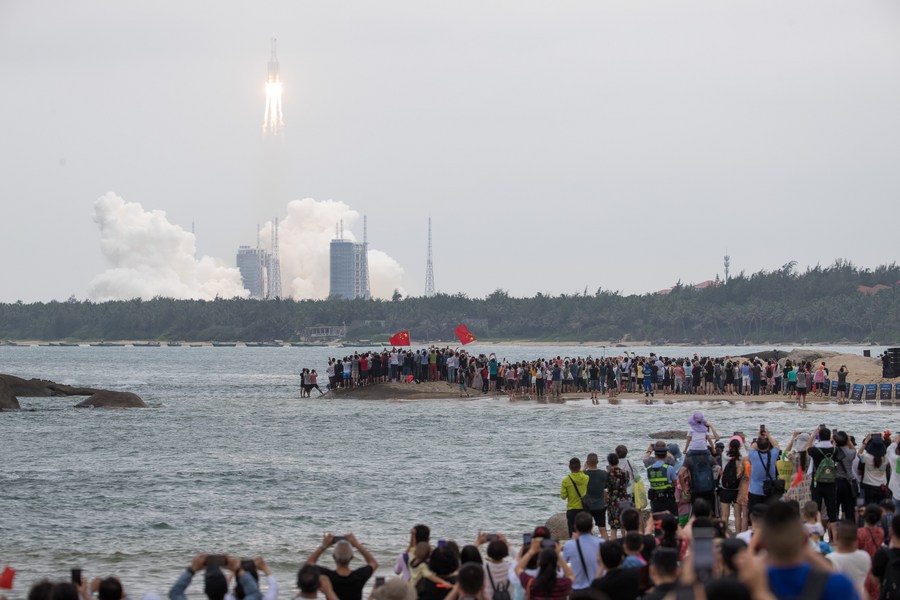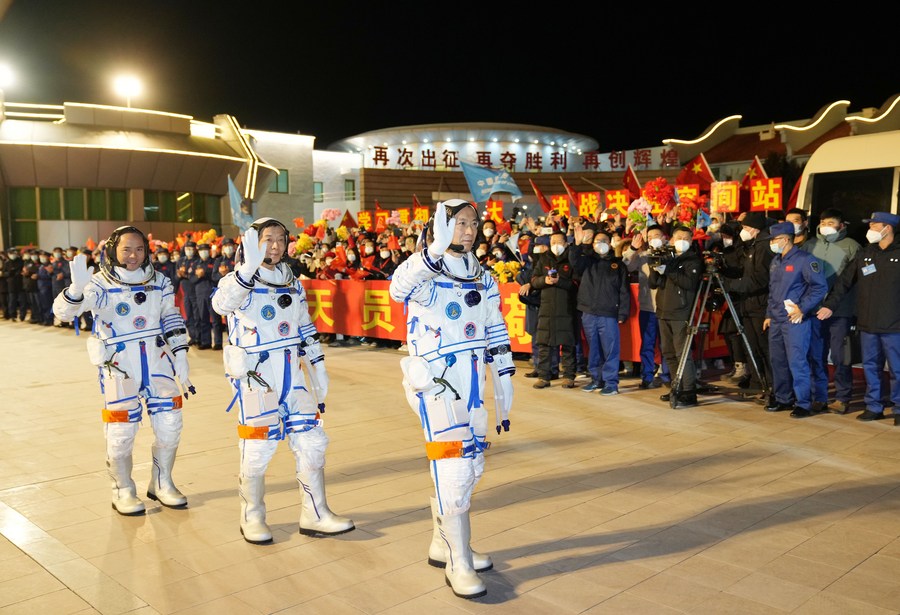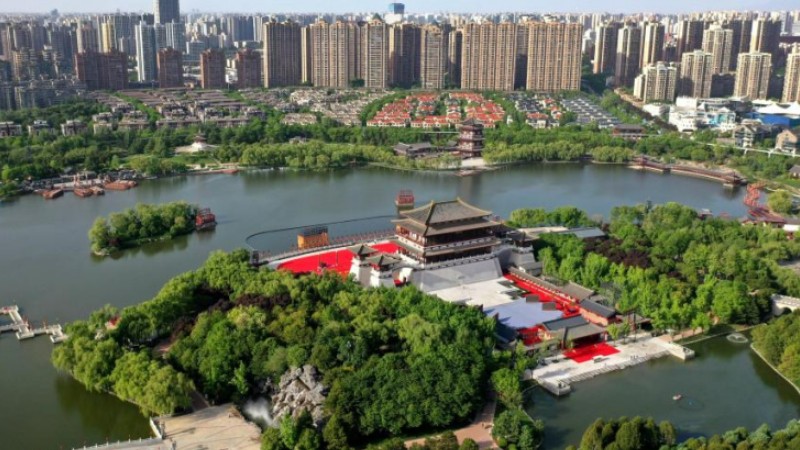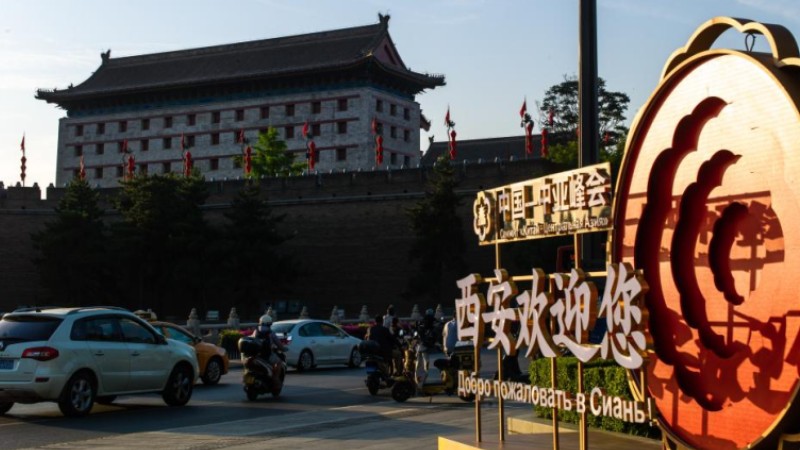Roaring space-themed tourism brings benefits down to Earth

The Long March-5B Y2 rocket, carrying the Tianhe module, blasts off from the Wenchang Spacecraft Launch Site in south China's Hainan Province, April 29, 2021. (Xinhua/Jin Liwang)
BEIJING, May 19 (Xinhua) -- Like many tropical island resorts around the world, China's Hainan attracts tourists courtesy of sandy beaches, fresh coconuts, and duty-free shopping. But the coastal province is now broadening its offering by developing an awe-inspiring activity: watching space launches.
The latest one was the liftoff of the Tianzhou-6 cargo craft on May 10 from the seaside Wenchang Spacecraft Launch Center, which is only a two-hour drive from the Haikou Meilan International Airport. Tens of thousands of visitors poured into the city of Wenchang, where the launch site is located. The rumble of the carrier rocket and the roar of the crowd swept over the beach.
Two days ahead of the space mission, rooms at major local hotels were already sold out at prices several times higher than usual. Buses became packed, streets grew congested and car queues were seen everywhere in Longlou, a "space town" in Wenchang, which has a resident population of less than 30,000.
"In the past, we were very secretive about the launch plans, which were revealed to the public just after the rockets blasted off into the sky," said Sun Jiadong, a renowned aerospace engineer and the head of the overall design team of China's first satellite Dongfanghong-1.
From a guarded secret to a live launch viewed by thousands, "the change reflects China's high confidence in space technology," Sun said.
The aerospace cause is both lofty and down to Earth. It matters not only for space exploration but also for economic and social development, and booming space-themed tourism is one of the best illustrations.
China's youngest and only coastal launch facility, the Wenchang launch site was first used in 2016. It has witnessed several launches of the country's important spacecraft, such as heavy-lift carrier rockets, space station modules, and lunar probes.
According to the local statistics bureau, from 2016 to 2022, the number of overnight tourist arrivals increased from 1.99 million to 3.62 million. Total tourism revenue rose from 1.4 billion yuan to 5.2 billion yuan (about 199 million U.S. dollars to 738 million U.S. dollars).

A see-off ceremony for three Chinese taikonauts of the Shenzhou-15 manned space mission is held at the Jiuquan Satellite Launch Center in northwest China, Nov. 29, 2022.(Xinhua/Li Gang)
The Jiuquan Satellite Launch Center in northwest China's Gobi Desert is also popular among tourists. The country's only site for manned spacecraft liftoff, Jiuquan has been listed as one of the world's top space travel destinations by Lonely Planet. Facilities such as aerospace museums, launch towers, and simulated taikonaut apartment compounds are hotspots recommended by travel guides.
It is easy to identify keen space fans near the site, as they carry tents and telescopes, waiting for the moment when rockets thunder skyward.
Business people across China also see money-making possibilities with the growth of the country's space-faring achievements.
The town of Lenghu in northwest China's Qinghai Province is known as "Mars Camp" due to its eerily eroded desert landscape that resembles the surface of the remote red planet.
One tour project offers a fully immersive experience of life on Mars. Participants are tasked with hiking in deserts, searching for water resources, and pretending to be taikonauts facing life-threatening challenges. Mars-related science courses are also provided to young visitors.
"Bookings stretch into October," said Yuan Zhenmin, executive deputy general manager of Lenghu Mars Town Culture and Tourism Development Co., which runs the project.
Similar Mars simulation bases have sprouted across the northwestern region after the launch of Mars probe Tianwen-1. Some boast space-themed hotels and restaurants, and some have sleeping capsules that can accommodate up to nearly 200 visitors. Photos of visitors donning a space suit in Mars Base 1, a simulated Martian habitat in Gansu Province, attracted wide media coverage this week.

This aerial photo taken on April 12, 2023 shows an astronomical telescope project of the Lenghu observatory site under construction in northwest China's Qinghai Province. (Xinhua/Chen Jie)
Tourism related to space enthusiasm improves the livelihoods of people on the ground, too. The town of Xichang, in southwest China's Sichuan Province, has been seeking to develop tourism related to aerospace, benefiting local farmers in the process.
Two kilometers away from the Xichang Satellite Launch Center, a small village of ethnic Yi people has become a cluster of family inns.
It used to be a poor village with no paved roads. Locals relied on farm work as their main source of income. Thanks to frequent satellite launches, Xichang has gained popularity among space lovers, and the nearby village took the ride to develop tourism. With the help of local tourism companies, villagers began running restaurants and guest houses for launch center visitors and planting value-added agricultural products, such as tea and walnuts, to raise earnings.

Contestants attend a costume show during a beauty contest for Yi ethnic group in Xichang, southwest China's Sichuan Province, July 28, 2016. (Xinhua/Liu Kun)
Wei Xiang, a researcher at the Chinese Academy of Social Sciences, said Xichang is a typical example of how space-themed tourism has boosted local leisure industries and tourism agriculture, which will increase production, create employment, and generate more economic benefits.
Space-themed tourism was under a spotlight on Friday, National Tourism Day, marked annually on May 19. Wei believes more industries, such as culture and education, will integrate with this burgeoning sector, providing momentum for tourism to take off.
Photos
Related Stories
- Blooming tourism refreshes preservation of China's ancient cities
- Travel agency-operated group tours resume for Taiwan residents traveling to mainland: spokesperson
- Theme parks celebrate business boom amid China's tourism recovery
- China successfully launches Tianzhou-6 cargo spacecraft
- Rural living gains popularity among Chinese urbanites
- Chinese tourism expert wins UNWTO Ulysses Prize
Copyright © 2023 People's Daily Online. All Rights Reserved.









